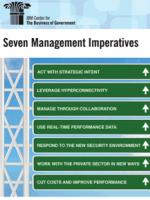
Seven Management Imperatives: Imperative Seven - Cut Costs and Improve Performance

The federal government faces an estimated annual structural deficit of $500 billion to $700 billion. A deficit of this magnitude represents a major threat to the economic health of the nation. The structural deficit is defined as the portion of the total annual deficit that results from a fundamental imbalance in receipts and expenditures, not just one-time occurrences or changes in the economic cycle. Steps to reduce and eliminate this structural deficit are urgently needed.
The Congress, the Obama administration, and state and local governments must put government spending on a path of fiscal sustainability for the longer term. Policy makers have focused on three cost-cutting opportunities for doing this:
- Eliminating wasteful programs
- Taking a longer-term view that focuses on entitlement program policy changes
- Using proven cost-saving strategies from the public and private sectors to make the daily operation of government much more efficient and deliver improved performance at a lower cost
Traditional Budget-Cutting Exercises Will No Longer Work
We have heard it before—the need to “do more with less.” But the situation is different this time, and much more difficult. Drastically reducing costs is a major undertaking, not a normal budget-cutting exercise. And, importantly, it presents an opportunity to not just cut programs and discretionary costs, but to transform how government does its business.
Across-the-board cuts and undifferentiated freezes that affect all programs and services in the same way can have perverse effects. Rather than looking only at program cuts, leaders and managers should view the need to achieve drastic reductions as an opportunity to reconsider their entire organizational structure as well as program business models.
Traditional Cost-Cutting Exercises Often Prove to be Temporary
More successful organizations invest in central staff who help identify systemic costs associated with organizational and program complexity and supply chain improvements. In doing so, they must be mindful of two important points.
Establish top-down cost savings targets. Delegating the responsibility for cost-cutting to the frontline organizations often results in cuts to long-term investments, like training, not to low-priority or poorly performing projects. Central staff focused on operational improvements can provide an enterprise-wide view to objectively identify high-priority and high-performance activities, not just set overall cost-reduction targets for the organization.
Recognize and capitalize on the cost of complexity. Failing to estimate and account for the cost of too many separate operations and support activities can lead organizations to overlook savings from reducing, standardizing, or sharing services, or making supply chain improvements. Central staff are in a better position to identify enterprise-wide and crossagency opportunities to capitalize on redundancies.
New Approaches are Needed to Truly Transform the Way Government Does Business
A big risk in the current cost-cutting debate is that not enough attention will be focused on the opportunity to improve operational performance by being smarter about the way government does business. The IBM Center for The Business of Government’s Strategies to Cut Costs and Improve Performance describes seven specific initiatives where technology-enabled productivity solutions can make a material difference in the performance of government programs, based on the experience of real cost savings and efficiencies achieved by public and private sector organizations. These seven strategies constitute a starter list of initiatives of this type.
By aggressively implementing these strategies, sustainable cost savings can be realized while, in many cases, improving operational performance.
Seven Strategies to Cut Costs and Improve Performance
- Consolidate information technology infrastructures
- Streamline government supply chains
- Reduce energy use
- Move to shared services for mission-support activities
- Apply advanced business analytics to reduce improper payments
- Reduce field operations footprint and move to electronic self-service
- Monetize the government’s assets
Getting it Done
The best approach is for top officials to appoint and empower a single individual to manage cost-cutting activity. While they may be supported by departmental staff or outside volunteers, someone needs to own the task and, ideally, report directly to the agency head. The secretary or deputy secretary should recruit a highly respected and experienced former CFO from the private sector to serve as the department’s “uber-manager” with the explicit mission to achieve dramatic cost saving.
Leaders such as cabinet secretaries or department heads will be critical enablers for cost-savings ideas, but we recommend that someone outside the impacted agencies be appointed to take the lead role for two reasons. First, those officials, like their elected bosses, have a great deal on their plate. Their days are filled with a constant stream of crises. Second, we believe that appointing an external voice can help inform the decisionmaking of agency heads as they make the tough choices about what must be cut.
The Role of Leaders and Managers
Cost-cutting is tough, unpleasant work. It requires choices that most of us would rather not make. Therefore, unwavering leadership is the most important characteristic for senior officials to display in a successful cost-cutting effort. While an individual department head might be able to reduce costs for a few years in an agency, it is very hard to bend the overall cost curve unless top leadership demands it.
This will be where government leaders and managers come in. They will be the ones who do the heavy lifting to implement major program adjustments and cutbacks, as well as harness major technological shifts and not just cut costs, but also adopt innovative practices to make government far more productive.



